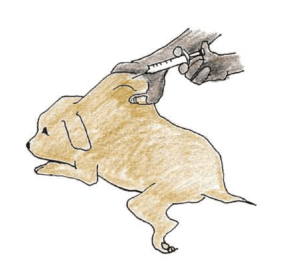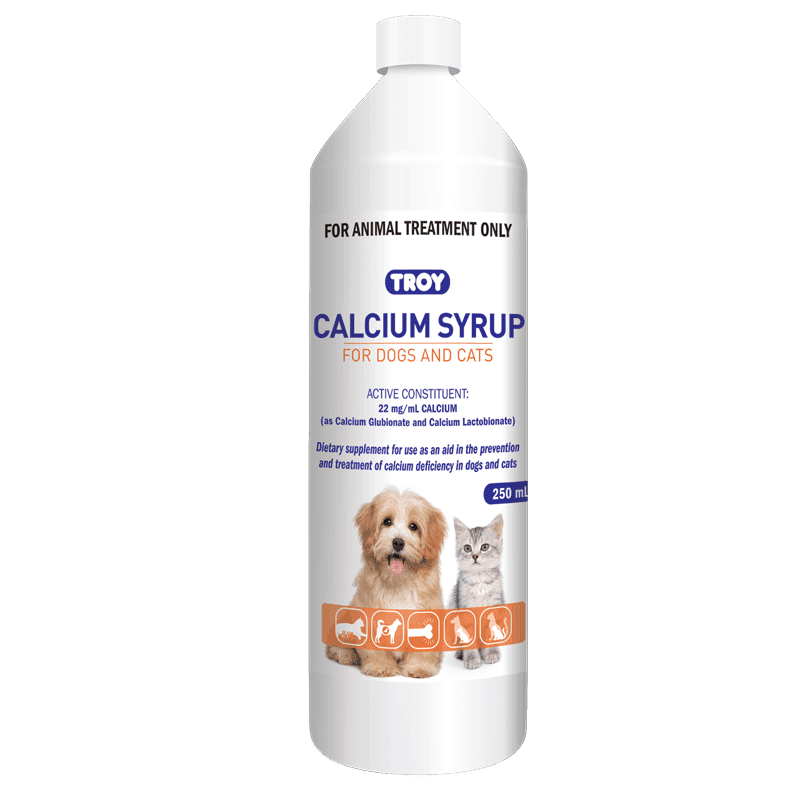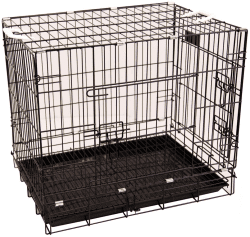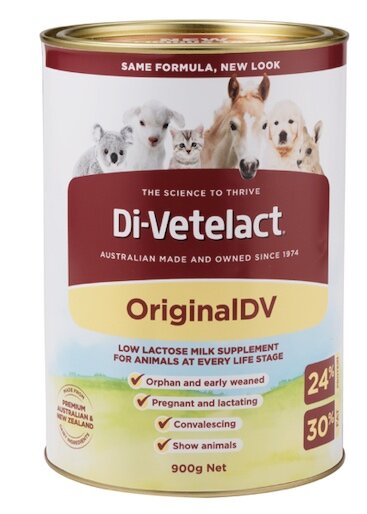CHAPTER ELEVEN
Dog breeding
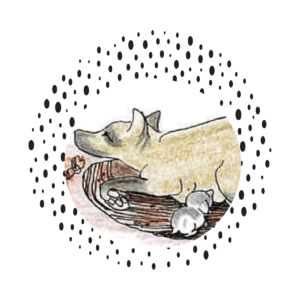
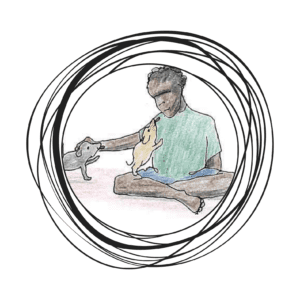
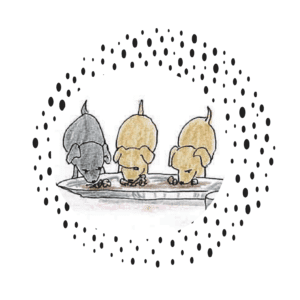
The female dog breeding cycle
Female dogs do not breed all the time.
They will only breed when they are ‘on heat’.
Most female dogs hit puberty and have their first heat when they are around 6 months old.
Small dogs come on heat younger than big dogs.
Once they have had their first heat, the female will come on heat two times every year.
In most communities the female dogs all come on heat at around the same time.
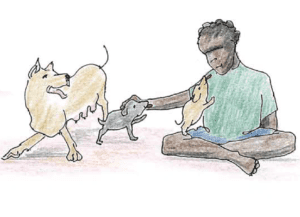
If the EHP knows when the females will be on heat, they can plan the breeding control program better. More information about stopping dogs breeding can be found in the Chapter 12.
EHPs can also let dog owners know about the dog breeding cycle. This can help owners to better understand dog breeding, and choose if they want their dog to breed or not.
There are 4 main parts to the female dog breeding cycle.
Each part has its own name:
1. Anoestrus
During anoestrus, female dogs won’t be interested in mating.
Anoestrus usually lasts 4 months.
It is usually the time that vets like to do the desexing operations. There is less blood going to the uterus (baby bag) and less chance of the dog bleeding after surgery.
2. Pro-oestrus
This is the start of the female coming on heat. It lasts 7-10 days.
During pro-oestrus, the owner may notice:
-
- dripping blood from the dog’s vulva
- the dog will lick herself a lot
- she will play with male dogs like she is a puppy again, but won’t stand to be mated
3. Oestrus
This is the time when the female is fertile, and the males and females will mate. Oestrus lasts about 1 week.
One of the first signs of oestrus is the female “flagging” her tail. The female will back up to dogs with her tail over to one side. She will stand for male dogs to mate her.
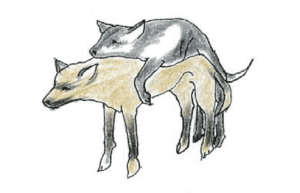
When dogs mate they become stuck together for about 20 minutes. This is called a “tied” mating.
No one should try to pull them apart during this time because this would be painful for both dogs, and people might get bitten.
If the female has had a tied mating, she will almost always get pregnant.
When oestrus is finishing and she comes off heat, the female dog will start snapping and growling at male dogs in a vicious way.
4. Dioestrus
This is the time after the heat.
If the female is pregnant dioestrus will last the 63 days of the pregnancy.
If the female is not pregnant dioestrus leads back into anoestrus and the cycle starts again. She will come on heat again in another 6 months.
About 2 – 3 days before the pups are born:
-
- the female starts looking for a safe place to have her pups (often this is in a little nest or hole, under a house)
- her vulva swells
- clear fluid drips from the vulva
- the owner may notice she is licking her vulva a lot
24 hours before the birth, a pregnant dog usually goes off her food.
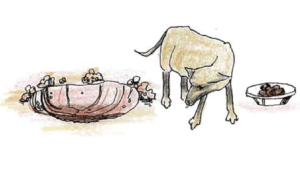
When she goes to her nest and starts panting quite hard, she is starting to give birth. This is sometimes called labour or ‘whelping’.
During whelping, the mother dog will strain to get the pups out.
The owner should keep a quiet eye on the dog as she whelps. They should check on her every 20 minutes but not go near her unless she is in trouble.
Children should be asked to keep quiet and not touch the pups until they are at least 2 days old. This will let the mother bond with her pups and stops her getting stressed.
Normal whelping
Pups mostly come out headfirst, but they can come out tail first too.
Each pup has its own placenta and bag of fluid.
Sometimes the pups come out still in the bag. The female will bite this open to get the puppy out. She will then eat the placenta and chew the cord off.
Sometimes a few pups are born, and then the placentas come out after.
The female dog will nudge and lick each pup to wake it up and get it near her teats.
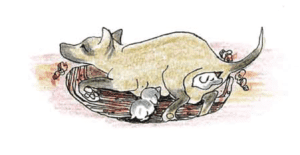
Pups start to drink within about one hour of being born. It is important the pups get this first feed. The first milk contains lots of antibodies to build the pups’ immune system.
There is usually a gap of 20 minutes to 2 hours between each pup being born. Sometimes the whelping can go over a whole day, but it is usually finished in a few hours.
Problems in pregnancy and whelping
Most female dogs whelp (give birth) very easily.
Problems can occur in any dog, but are more common in:
-
- female dogs that are having pups for the first time.
- breeds like Staffordshire Bull Terrier that have narrow hips but big shoulders and wide heads.
- very small dogs like Chihuahuas. If owners want to breed these dogs it is very important that small females are only bred with small males. Big male dogs mating small females will cause big pups that might get stuck.
Dystocia
When female dogs have trouble giving birth, it is sometimes called ‘dystocia’. Dystocia is serious and without help, can cause both the mother and pups to die.
The female dog is in trouble if:
-
- She is straining hard for more than 30 minutes and no puppy is born, or the pup is stuck. It might be around the wrong way or too big.
- She is still in labour off and on (still straining) and no puppy is born after 2 hours.
- She is not very hungry or eating well more than 2 days after giving birth. This can be the sign of an infection. A dead pup may still be inside her or a placenta may not have come out.
If these things are happening, it is best if the owner can take the mother dog and her pups to see the vet.
If the owner can’t take the dogs to see the vet, the EHP might be able to call the vet and get advice over the phone, for helping the dog.
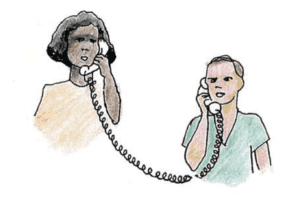
False pregnancy
Some female dogs can have what is called a false pregnancy.
This is when the female looks and acts pregnant but there are no pups inside her.
She will get swollen teats, make a nest, start panting and even collect kid’s toys or people’s socks to care for like pups.
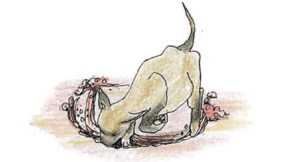
False pregnancies last 63 days. The female then goes into anoestrus in the normal way.
Infection in the uterus (baby bag)
After a dog has been on heat, she may get an infection in her uterus. The baby bag fills with pus.
The owner may notice the pus dripping out the vulva.
Sometimes the baby bag is closed. The pus then builds up inside the dog and cannot get out. This makes the dog very sick. She will be quiet, stop eating, and lose weight. Without treatment, she will die.
Infections like this are quite common and are a good reason to get female dogs desexed.
Milk fever (low calcium)
This is common in small breeds of dogs, or dogs who are not fed well after they give birth.
Milk fever happens when there is not enough calcium in the mother’s blood when she starts making milk for the pups.
The sickness usually starts in the first week after the dog has pups, but it can happen any time in the first 6 weeks after whelping.
The signs are:
-
- the mother will start to tremble and shake.
- in the end the mother lies down and has full fits.
If dogs with bad milk fever are not given calcium, they can die.
If you think a dog in your community has milk fever, talk to your vet about treatment. The vet might recommend that you keep a bottle of calcium syrup in your medicine kit, ready for cases of milk fever.
As the EHP, you can also let owners know about feeding high calcium foods to dogs with pups.
Dog foods made for pups, like Puppy Pal, are high in energy and calcium, and are good to feed to the mother dog while she is producing milk.
Puppies dying
Sometimes most of the pups in a litter will die in the first week after they are born.
Sometimes the pups born from the same mum will always die.
The main reasons groups of pups die like this are:
-
- The mother had a difficult labour. These pups will be born weak and tired.
- The mother eats the pups or lies on them and suffocates them. This will happen more if the mum is stressed.
- The mother does not make enough milk. This can happen if she is not well fed or is stressed.
- The pups get an infection from parasites and germs like Hookworm, Salmonella and Giardia.
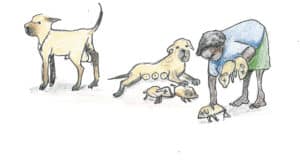
To stop her from getting stressed, the mother needs a safe place that is warm and away from other dogs, family noise and children’s constant love.
A regular anti-parasite treatment program will also help to keep mother dogs and their puppies healthy. See Chapter 7 for more information about treating dogs for parasites.
Looking after pups
As the EHP, you might get asked by community members, how to look after pups properly.
There are lots of different things that families can do to make sure their pups grow up healthy and safe:
1. Give the mother and pups a safe nest
While the pups are small, it is important to give the mother dog and her pups a safe and quiet nest. This place should be:
-
- not too hot and not too cold
- somewhere peaceful, that isn’t too noisy or busy, but that allows adults to check on the mother dog and her pups
- somewhere that is easy to clean
A dog crate that is covered with a towel or blanket can be a good nest for a mother dog and her pups.
If a dog crate is used, it’s important that the crate door is always open so the mother dog can wander in and out as she wants.
A big cardboard box can be used as a nest. Turn the box upside down, and cut a doorway in the side of the box, so it is like a cave for the mother dog.
2. Keep the nest clean
Make sure faeces or rubbish like old bones are removed from the nest each day.
This job should be done carefully and quietly, without disturbing the mother and her pups.
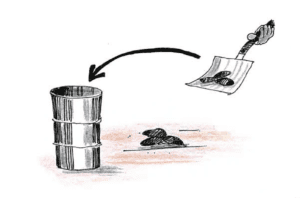
3. Handle pups gently and carefully
Pups are born with their eyes shut. Their eyes open when they are about 10 days old.
It is best to leave the pups alone with their mother, at least until their eyes open.
Mother dogs can be protective about their pups, and sometimes might snap if they think their pups are in danger.
Children normally like to give pups lots of love, and carry pups around, but this is not good for the pups or their mum. It can stop the mum bonding with her puppies, or make her stressed about their safety. The pups can also miss feeds when they are carried away from home.
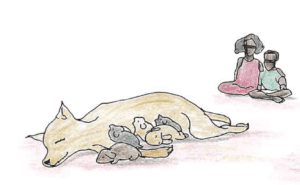
Once the pups are old enough, when children are handling pups, they should sit down quietly near the mother dog. An adult should always watch little children with pups. The adult can teach little children how to be gentle with pups.
4. Feeding pups
Mother’s milk is the best food for young pups, but if the mother dog is not feeding the pups well, the puppies might need to be bottle fed with puppy milk formula.
As the EHP, you can stock puppy milk, bottles and teats in your medicine kit, ready to use for puppies that might need it.
Did you know?
Not all milks are the same! While cow’s milk is good for calves, it is not very good for young pups. Cow’s milk can make puppies get sick with diarrhoea.
Powdered puppy milk is a much better option to give to puppies, and is something that can be bought from pet stores or supplied by the vet.
Once the pups are about two weeks old, owners can start to add solid food to the pups’ diet.
The pups should be introduced to solid food slowly, to let their gut get used to it. A teaspoon or two is enough for the first few days.
Owners should choose ‘Puppy’ tin or dry food. Puppy food has more protein and calcium in it than adult food. Dry food can be soaked in water or puppy milk to make it softer for the pups.
Pups can be weaned at about 6 weeks old. At this age they will need 4 feeds of good food every day, spaced throughout the day.
It is important that pups have clean food bowls and can get clean water to drink. This helps to stop them getting sick from parasites in the soil.
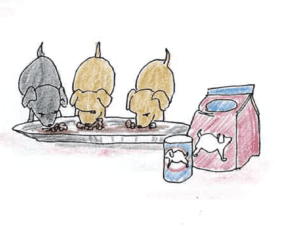
5. Worming pups
Pups need to be wormed with a puppy wormer, every 2 weeks until they are 12 weeks old.
After this they can have allwormer tablets every month until they are 6 months old.
Once they are 6 months old, all dogs can be wormed every 3 months.
Chapter 19 has more information about different types of worming medicines available for pups and adult dogs.
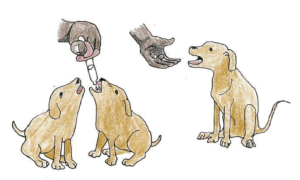
6. Vaccinating pups
While they are drinking from their mother, pups are normally protected against diseases like parvovirus.
As soon as they are weaned, the pups are no longer getting antibodies in the mother’s milk, so they are no longer protected.
Talk to your vet about the best time to give pups their first vaccinations against diseases like parvovirus.
Chapter 3 has more information about the immune system and vaccination programs.
